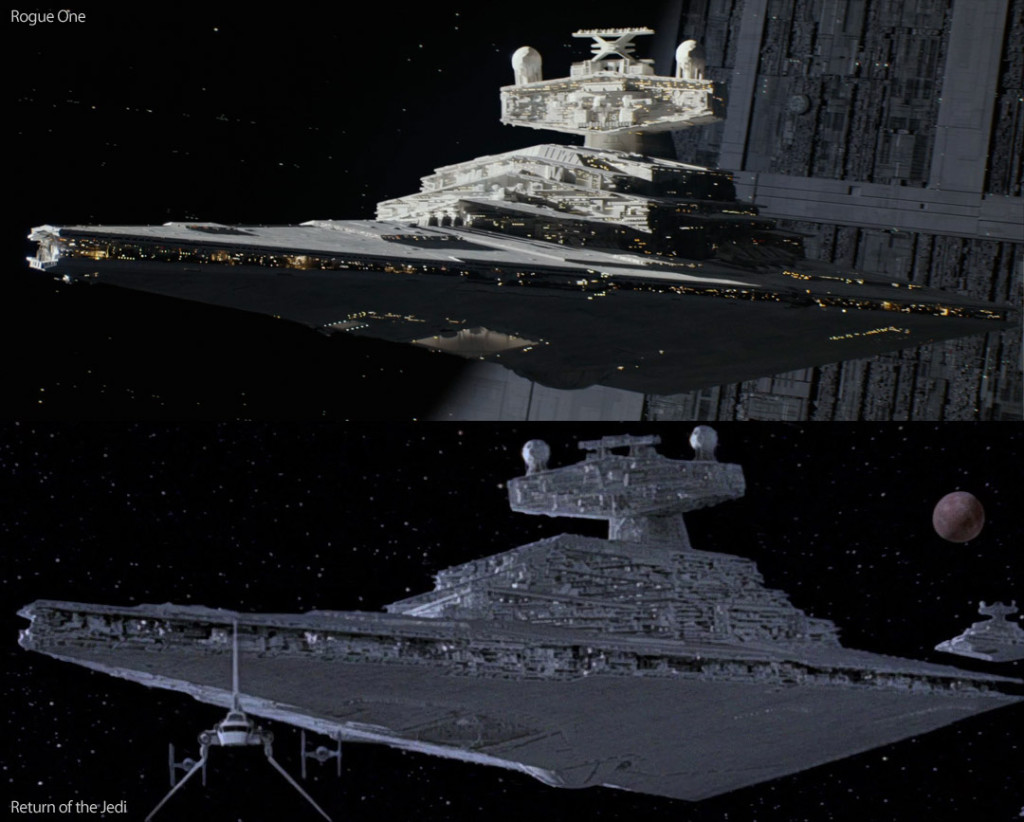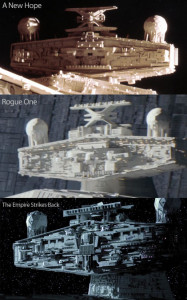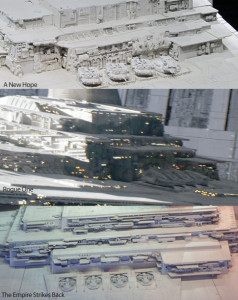A few days ago, the first teaser for the first Star Wars anthology movie, Rogue One, dropped.
There’s one shot in particular I’d like to talk about. You can probably guess what the shot is from my specialty, given how little space-stuff was in the trailer. First, some background.
 Two Star Destroyers, both alike in dignity…1As it happens the angle of the Star Destroyer shot in the Rogue One trailer is almost identical to the angle of the second shot in Return of the Jedi, so there’s a great comparison between the three-footer-inspired design and the eight-and-a-half foot miniature.
Two Star Destroyers, both alike in dignity…1As it happens the angle of the Star Destroyer shot in the Rogue One trailer is almost identical to the angle of the second shot in Return of the Jedi, so there’s a great comparison between the three-footer-inspired design and the eight-and-a-half foot miniature.
In visual effects, multiple models are often constructed to represent the same object. There are various reasons to do so, and it happens as much with CGI models today as it did with physical miniatures in the past. In this case, there were two main miniatures constructed to represent the Imperial Star Destroyer. For the original Star Wars, in 1977, a three-foot-long model was built. It was supplanted (more or less) by an eight-and-a-half foot long model built for The Empire Strikes Back.2Modelers, Miniatures & Magic has two galleries of photos of the larger model. The original model was redressed to match the most obvious differences in the large version, and they were both used in ESB.3MM&M also has two galleries of photos the smaller model, with the modifications made for ESB.
Some of the differences between the two are that the three-footer has larger and fewer details, it’s off-white rather than the light grey of the larger version, the cannons flanking the superstructure are larger, the globes above the bridge tower are splayed outward (perpendicular to the surface they rest on) rather than extending directly upward, the X-shaped antenna in between the globes points forward rather than upward, and the model wasn’t rigged with window lights.
While in-universe technical information says these are two different variants of Star Destroyer, (the Imperial-I and Imperial-II), almost all depictions of Star Destroyers have used the ESB version as their model, even when they’re set before the original film, or referred to as Imperial-I-type ships. The model of the ship used in the cartoon series Star Wars: Rebels is more consistent with the ESB version, though it does change the orientation of the X-shaped antenna to match the smaller miniature. That’s probably the most obvious tell-tale,4Changing that antenna is also the most visible alteration made to the three-foot model to match the eight footer for ESB. It could be the only alteration, but photos of the smaller model as it appeared before it was modified for ESB are very rare, so I don’t want to assume. and any other differences are frequently glossed over.
All of which brings me to my point: the Star Destroyer seen in the Rogue One trailer is an unbelievably faithful recreation of the three-foot model as it appeared in the original Star Wars.
When discussing updating things like the original Star Trek5Of course, the Star Trek: Enterprise episode “In a Mirror Darkly” included a subtly updated version of the original 1960s ship and sets. or Babylon 5,6Probably another bad example, as the B5Scrolls Facebook fan page has posted a few shots of ’90s-era Babylon 5 models with more modern lighting and at higher resolution. Maybe this is mostly striking to me because the three-foot Star Destroyer has been largely glossed over before this, and not as any kind of commentary on the timelessness of older visual effects designs in general.¯\_(ツ)_/¯ my philosophy has been to approach a new version as if you’re looking at the original with your glasses on. This is probably the best execution of that philosophy I’ve ever seen. I wish I could redo a shot from Star Wars using this model, then pan-and-scan it and dub it to a VHS tape, just to see how close it would look to the original model in the low-fi version I saw growing up.
Even in the shot in the trailer, you can see the putting-glasses-on effect. The flat color scheme and the coarse detailing make it look small and plastic in the beginning of the shot, but as it closes in on the camera, and you can more clearly see the teeny-tiny window lights7The lights, I might add, are period-appropriate; individual points of yellowish light, as if they were fiber optics lit by an incandescent bulb. and extremely small added nurnies/greebles, the scale begins to sell and it jumps from three feet long to five thousand in a second. It probably also helps that the whole length of it stays in focus, something that can be tricky with shot like that on a miniature, especially one as small as the original Star Destroyer. 8A good example of this is in a shot from Star Trek: The Motion Picture, where the Enterprise passes extremely close to the camera on its way out of drydock and falls out of focus. I’ve heard Douglas Trumbull wanted a version of the ship that was two or three times larger to address that issue, which I always think about when someone mentions that people at ILM thought the existing eight-foot-miniature was too large and heavy to deal with.
From one perspective, this isn’t unprecedented. A tremendous amount of work went into creating a faithful Millennium Falcon for The Force Awakens, but there are differences. Like the Star Destroyer, the Falcon was redone and modified as the original Star Wars trilogy progressed, so they were building on the most recent version, not a largely glossed-over early incarnation (though it now seems to be a given that if the Falcon appears in a young Han Solo movie, it’ll be in it’s original, three-landing-geared appearance).
There are similar variations among X-Wings, Y-Wings, and the Falcon, between both different miniatures and the miniatures versus their full-scale versions, but the trailer isn’t clear enough and I’m not enough of an expert to distinguish between them at a glance. I will spare a moment to say I’m also pleased by how the Death Star appears in Rogue One, though mostly because it seems to be deceptively hard to get it right. Most fan-art, or even official pictures, seem to have trouble matching the look of the original. Even in Revenge of the Sith, the Death Star framework has a noticeably smaller superlaser dish than in the prior depiction.
One last note: While researching this post, I found a re-used effects element in The Empire Strikes Back that I never noticed before. In the shot where the Falcon dives down after leading three Star Destroyers into a collision course, one of the Destroyers is reused as the ship chasing the Falcon out of the asteroid field later in the film. The context is different enough, and its first appearance is in a sequence, so the reuse doesn’t stand out. Clever.
Acknowledgements to this article, whose comparison images are probably the reason I could recognize a recreation of the three-footer on sight.
Updated 2018-02-23:
A few quick notes since I saw people are still stumbling on to this article almost two years later.
- The Star Destroyer model wasn’t finished when the teaser trailer was released (in fact, neither of the shots with it appeared in the final film), so there are some additional details on the R1 model that I wasn’t aware of when I wrote this, because they didn’t exist yet, in addition to the ones you just can’t see from the one shot in the trailer.
- Some months after I wrote this, but before the movie came out, John Knoll gave a talk at Star Wars Celebration going into some detail about how they built this model (and also how they recreated the Death Star, and various graphics and costumes). The video should be queued to when he begins discussing the destroyer.
- After the movie came out, ILM released several VFX breakdowns. This one includes comparisons between the final R1 model and the original three-foot miniature (give-or-take the modifications made to it for ESB to closer resemble its larger sibling).
- Interestingly, there actually was a subtle change made to the shape of the X-Wing for Rogue One, making the fuselage a bit smoother (though, I assume, harder to build at full-scale).
- And I was wrong about the Solo Falcon being built with three legs because that’s how it was in ANH. It actually does have five legs, presumably because they want to keep using the full-sized one they built for TLJ and don’t care to CGI away the undercarriage. Oh, well, easy come, easy go.
| ↑1 | As it happens the angle of the Star Destroyer shot in the Rogue One trailer is almost identical to the angle of the second shot in Return of the Jedi, so there’s a great comparison between the three-footer-inspired design and the eight-and-a-half foot miniature. |
|---|---|
| ↑2 | Modelers, Miniatures & Magic has two galleries of photos of the larger model. |
| ↑3 | MM&M also has two galleries of photos the smaller model, with the modifications made for ESB. |
| ↑4 | Changing that antenna is also the most visible alteration made to the three-foot model to match the eight footer for ESB. It could be the only alteration, but photos of the smaller model as it appeared before it was modified for ESB are very rare, so I don’t want to assume. |
| ↑5 | Of course, the Star Trek: Enterprise episode “In a Mirror Darkly” included a subtly updated version of the original 1960s ship and sets. |
| ↑6 | Probably another bad example, as the B5Scrolls Facebook fan page has posted a few shots of ’90s-era Babylon 5 models with more modern lighting and at higher resolution. Maybe this is mostly striking to me because the three-foot Star Destroyer has been largely glossed over before this, and not as any kind of commentary on the timelessness of older visual effects designs in general.¯\_(ツ)_/¯ |
| ↑7 | The lights, I might add, are period-appropriate; individual points of yellowish light, as if they were fiber optics lit by an incandescent bulb. |
| ↑8 | A good example of this is in a shot from Star Trek: The Motion Picture, where the Enterprise passes extremely close to the camera on its way out of drydock and falls out of focus. I’ve heard Douglas Trumbull wanted a version of the ship that was two or three times larger to address that issue, which I always think about when someone mentions that people at ILM thought the existing eight-foot-miniature was too large and heavy to deal with. |



